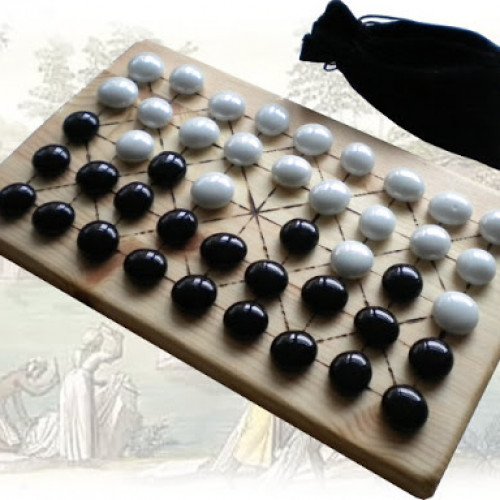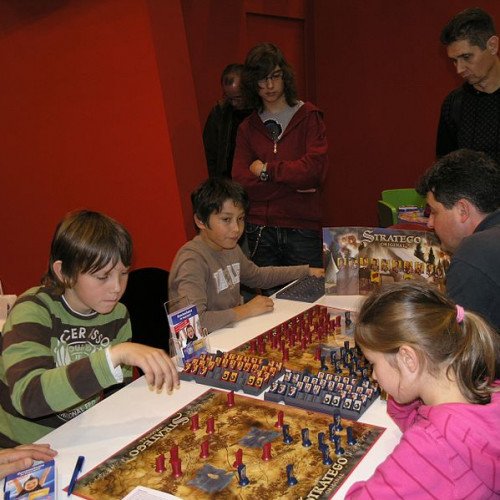FANORONA VS STRATEGO

FANORONA
Fanorona (Malagasy pronunciation: [fə̥ˈnurnə̥]) is a strategy board game for two players. The game is indigenous to Madagascar. Fanorona has three standard versions: Fanoron-Telo, Fanoron-Dimy, and Fanoron-Tsivy. The difference between these variants is the size of board played on. Fanoron-Telo is played on a 3×3 board and the difficulty of this game can be compared to the game of tic-tac-toe. Fanoron-Dimy is played on a 5×5 board and Fanoron-Tsivy is played on a 9×5 board—Tsivy being the most popular. The Tsivy board consists of lines and intersections that create a grid with 5 rows and 9 columns subdivided diagonally to form part of the tetrakis square tiling of the plane. A line represents the path along which a stone can move during the game. There are weak and strong intersections. At a weak intersection it is only possible to move a stone horizontally and vertically, while on a strong intersection it is also possible to move a stone diagonally. A stone can only move from one intersection to an adjacent intersection. Black and white pieces, twenty-two each, are arranged on all points but the center. The objective of the game is to capture all the opponents pieces. The game is a draw if neither player succeeds in this. Fanorona is very popular in Madagascar. According to one version of a popular legend, an astrologer had advised King Ralambo to choose his successor by selecting a time when his sons were away from the capital to feign sickness and urge their return; his kingdom would be given to the first son who returned home to him. When the king's messenger reached Ralambo's elder son Prince Andriantompokondrindra, he was playing fanorona and trying to win a telo noho dimy (3 against 5) situation, one that is infamously difficult to resolve. As a result, his younger brother Prince Andrianjaka was the first to arrive and inherited the throne.
Statistics for this Xoptio

STRATEGO
Stratego is a strategy board game for two players on a board of 10×10 squares. Each player controls 40 pieces representing individual officer and soldier ranks in an army. The pieces have Napoleonic insignia. The objective of the game is to find and capture the opponent's Flag, or to capture so many enemy pieces that the opponent cannot make any further moves. Stratego has simple enough rules for young children to play but a depth of strategy that is also appealing to adults. The game is a slightly modified copy of an early 20th century French game named L'Attaque. It has been in production in Europe since World War II and the United States since 1961. There are now two- and four-handed versions, versions with 10, 30 or 40 pieces per player, and boards with smaller sizes (number of spaces). There are also variant pieces and different rulesets. The International Stratego Federation, the game's governing body, sponsors an annual Stratego World Championship. The name Stratego was first registered in 1942 in the Netherlands. The United States trademark was filed in 1958 and registered in 1960 to Jacques Johan Mogendorff and is presently owned by Jumbo Games as successors to Hausemann and Hotte, headquartered in the Netherlands. It has been licensed to manufacturers such as Milton Bradley, Hasbro and others, as well as retailers such as Barnes & Noble, Target stores, etc. The game box contents are a set of 40 gold-embossed red playing pieces, a set of 40 silver-embossed blue playing pieces, a glossy folding 15 1⁄2 in × 18 1⁄2 in (39 cm × 47 cm) rectangular cardboard playing board imprinted with a 10×10 grid of spaces, and instructions printed in English on the underside of the box top. The early sets featured painted wood pieces, later sets colored plastic. The pieces are small and roughly rectangular, 1 in (25 mm) tall and 3⁄4 in (19 mm) wide, and unweighted. More modern versions first introduced in Europe have cylindrical castle-shaped pieces. Some versions have a cardboard privacy screen to assist setup. A few versions have wooden boxes or boards.